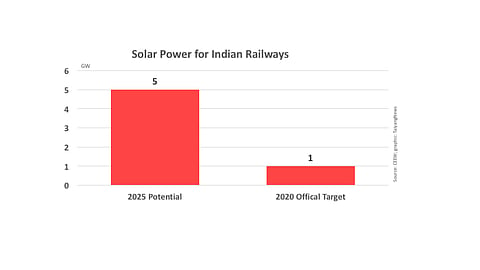

Indian Railways can achieve 5 GW of solar power capacity by 2025, with 3.9 GW coming from utility scale projects and 1.1 GW from rooftop projects. A new report from the Council on Energy, Environment and Water (CEEW), a non-profit policy research institution, ´ states that this would help Indian Railways achieve an electricity mix of 25% from renewables. This would cost $3.6 billion.
At present, Indian Railways has a target of 1 GW of solar power capacity and 200 MW of wind power capacity by 2020. Out of this, it has installed 16 MW of solar and 37 MW of wind by March 2017. It has tendered 255 MW of rooftop solar projects, of which 80 MW has been awarded. Another 250 MW of land based solar projects have been tendered out of which 50 MW were awarded. The department is on track to achieve its 1 GW capacity by 2019 – 1 year ahead of its targeted year.
The study assesses the challenges and opportunities in such a scenario. "The Indian Railways is a guaranteed consumer and has a growing electricity demand, which should mitigate any perceived off-taker risks that project developers or investors may see," the report says.
The report identifies 12 states where this capacity could come up. These states are ranked in terms of the ease of business for developers. Madhya Pradesh ranks the highest for utility scale solar power projects, and Karnataka ranks highest in rooftop projects.
"Indian Railways' ambitious renewable energy push will not only lower energy bills for the Railways but will also advance India's climate goals and serve as a role model for low-carbon public transportation across the world," said CEEW CEO Dr Arunabha Ghosh. Adding, "The Railway Board needs to pursue stronger collaboration with state governments and electricity regulators to establish a robust ecosystem for ensuring developer and investor confidence in its renewable projects. An R&D fund, in partnership with MNRE and Ministry of Science and Technology, could be set up to promote innovation on energy efficiency and integration of renewables in the Railways."
The report titled 'Decarbonising the Indian Railways Scaling Ambitions, Understanding Ground Realities' is available for free download on CEEW's website.
.png?w=50&fm=png)